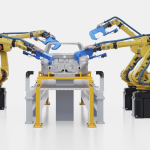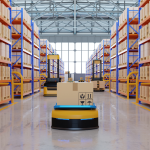AI-driven process optimization, composable commerce, and personalization are reshaping supply chain and manufacturing strategies in 2025.
Companies are investing in three key technologies to improve supply chain workflows: AI-powered process optimization, composable commerce, and demand-driven personalization. These advancements are changing how businesses manage logistics, procurement, and customer engagement.
AI-Powered Process Optimization
Artificial intelligence is moving beyond chatbots and recommendation engines to back-end automation that improves efficiency. AI is now embedded in logistics and procurement, creating predictive maintenance models that forecast equipment failures and automate parts ordering.
Advanced AI systems could soon handle complex tasks such as coding, logistics planning, and data synthesis. While this is still developing, companies can already use AI to automate data analysis, connect business systems, and optimize procurement. These capabilities reduce manual work and improve decision-making, allowing supply chain leaders to respond more effectively.
Composable Commerce for Greater Flexibility
Traditional e-commerce platforms often force businesses to choose between rigid, out-of-the-box solutions or expensive custom-built systems. Composable commerce provides an alternative by integrating best-in-class software solutions without the need for extensive customization or middleware.
By combining enterprise resource planning (ERP), product information management (PIM), content management systems (CMS), and payment service providers (PSP), manufacturers and distributors can create a seamless data flow. This reduces errors, minimizes IT downtime, and improves efficiency. The result is a supply chain system that is more adaptable and responsive to business needs.
Personalization Driving Demand Fulfillment
A recent Adobe and Forrester report found that 66% of B2B buyers expect a personalized purchasing experience. Meeting this demand requires digital tools, including AI-driven product recommendations, guided selling, and customer portals.
Customer portals allow businesses to offer buyers a customized online experience, providing personalized catalogs, localized content, and pre-negotiated pricing. These portals streamline reordering, order tracking, and invoice management, making transactions easier and increasing customer satisfaction. Personalization also supports targeted upselling and cross-selling, reinforcing buyer relationships while increasing revenue.
Building a More Efficient Supply Chain
Companies that integrate AI-driven automation, composable commerce, and personalized customer experiences will improve efficiency and responsiveness. Instead of attempting a large-scale transformation, businesses can focus on one solution at a time and expand from there.







